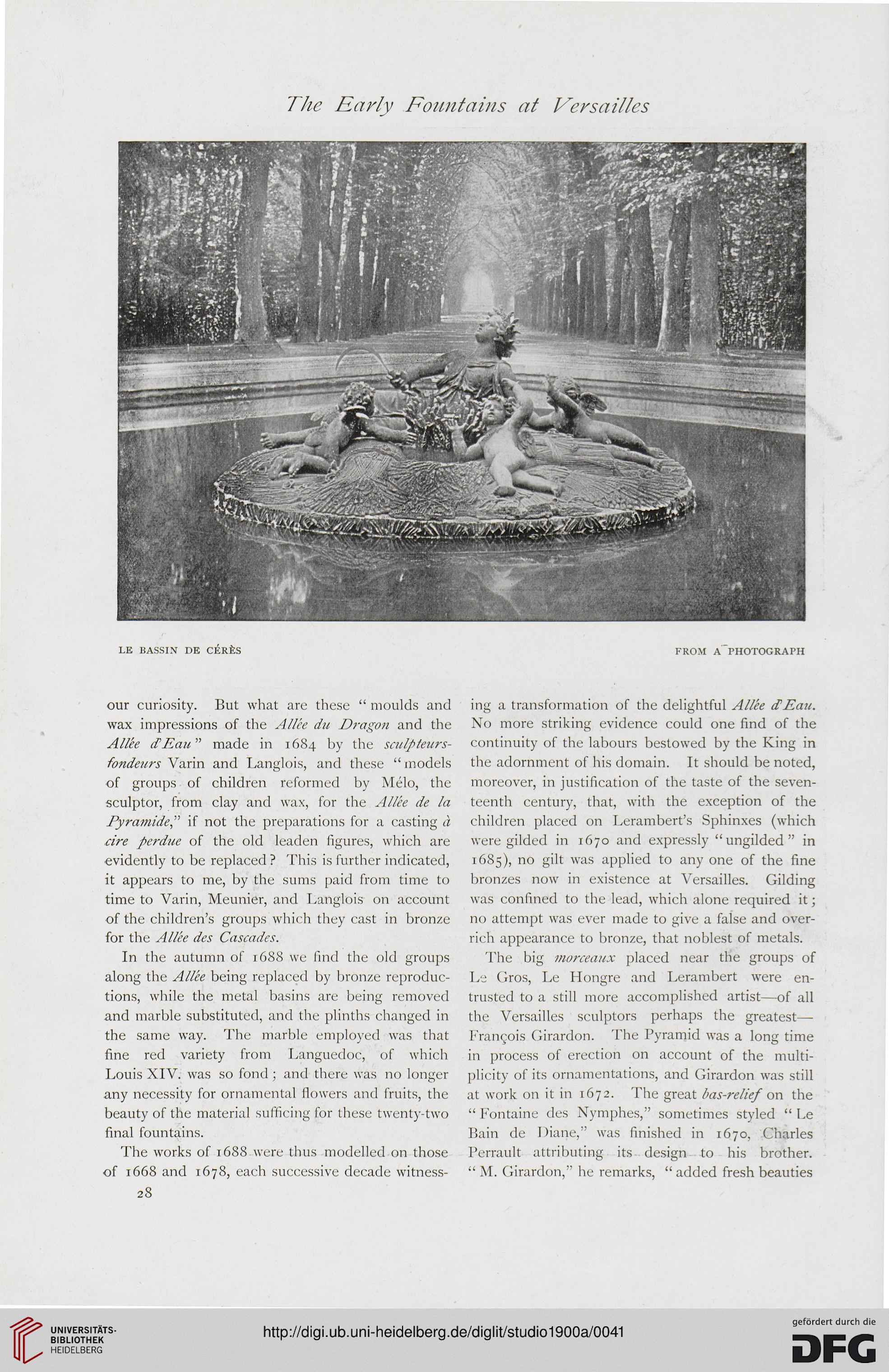The Early Fountains at Versailles
our curiosity. But what arc these " moulds and
wax impressions of the Alike du Dragon and the
A/lee dEau" made in 1684 by the sculp•leurs-
fondeurs Varin and Langlois, and these " models
of groups of children reformed by Melo, the
sculptor, from clay and wax, for the Alice de la
Pyramide" if not the preparations for a casting a
are perdue of the old leaden figures, which are
evidently to be replaced ? This is further indicated,
it appears to me, by the sums paid from time to
time to Varin, Meunier, and Langlois on account
of the children's groups which they cast in bronze
for the Alice des Cascades.
In the autumn of 1688 we find the old groups
along the Allee being replaced by bronze reproduc-
tions, while the metal basins are being removed
and marble substituted, and the plinths changed in
the same way. The marble employed was that
fine red variety from Languedoc, of which
Louis XIV. was so fond ; and there was no longer
any necessity for ornamental flowers and fruits, the
beauty of the material sufficing for these twenty-two
final fountains.
The works of 1688 were thus modelled on those
of 1668 and 1678, each successive decade witness-
28
ing a transformation of the delightful Allee dEau.
No more striking evidence could one find of the
continuity of the labours bestowed by the King in
the adornment of his domain. It should be noted,
moreover, in justification of the taste of the seven-
teenth century, that, with the exception of the
children placed on Lerambert's Sphinxes (which
were gilded in 1670 and expressly "ungilded" in
1685), no gilt was applied to any one of the fine
bronzes now in existence at Versailles. Gilding
was confined to the lead, which alone required it;
no attempt was ever made to give a false and over-
rich appearance to bronze, that noblest of metals.
The big morceaux placed near the groups of
Le Gros, Le Hongre and Lerambert were en-
trusted to a still more accomplished artist—of all
the Versailles sculptors perhaps the greatest—
Francois Girardon. The Pyramid was a long time
in process of erection on account of the multi-
plicity of its ornamentations, and Girardon was still
at work on it in 1672. The great bas-relief on the
" Fontaine ties Nymphes," sometimes styled " Le
Bain de Diane," was finished in 1670, Charles
l'errault attributing its design to his brother.
" M. Girardon," he remarks, " added fresh beauties
our curiosity. But what arc these " moulds and
wax impressions of the Alike du Dragon and the
A/lee dEau" made in 1684 by the sculp•leurs-
fondeurs Varin and Langlois, and these " models
of groups of children reformed by Melo, the
sculptor, from clay and wax, for the Alice de la
Pyramide" if not the preparations for a casting a
are perdue of the old leaden figures, which are
evidently to be replaced ? This is further indicated,
it appears to me, by the sums paid from time to
time to Varin, Meunier, and Langlois on account
of the children's groups which they cast in bronze
for the Alice des Cascades.
In the autumn of 1688 we find the old groups
along the Allee being replaced by bronze reproduc-
tions, while the metal basins are being removed
and marble substituted, and the plinths changed in
the same way. The marble employed was that
fine red variety from Languedoc, of which
Louis XIV. was so fond ; and there was no longer
any necessity for ornamental flowers and fruits, the
beauty of the material sufficing for these twenty-two
final fountains.
The works of 1688 were thus modelled on those
of 1668 and 1678, each successive decade witness-
28
ing a transformation of the delightful Allee dEau.
No more striking evidence could one find of the
continuity of the labours bestowed by the King in
the adornment of his domain. It should be noted,
moreover, in justification of the taste of the seven-
teenth century, that, with the exception of the
children placed on Lerambert's Sphinxes (which
were gilded in 1670 and expressly "ungilded" in
1685), no gilt was applied to any one of the fine
bronzes now in existence at Versailles. Gilding
was confined to the lead, which alone required it;
no attempt was ever made to give a false and over-
rich appearance to bronze, that noblest of metals.
The big morceaux placed near the groups of
Le Gros, Le Hongre and Lerambert were en-
trusted to a still more accomplished artist—of all
the Versailles sculptors perhaps the greatest—
Francois Girardon. The Pyramid was a long time
in process of erection on account of the multi-
plicity of its ornamentations, and Girardon was still
at work on it in 1672. The great bas-relief on the
" Fontaine ties Nymphes," sometimes styled " Le
Bain de Diane," was finished in 1670, Charles
l'errault attributing its design to his brother.
" M. Girardon," he remarks, " added fresh beauties




